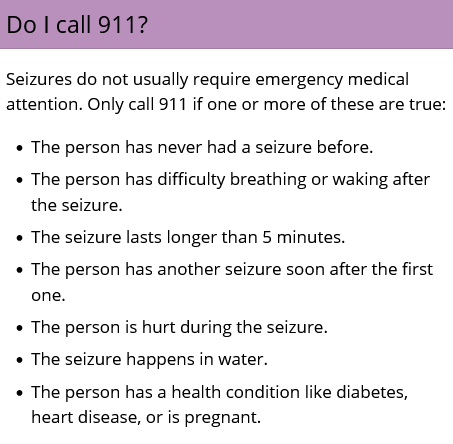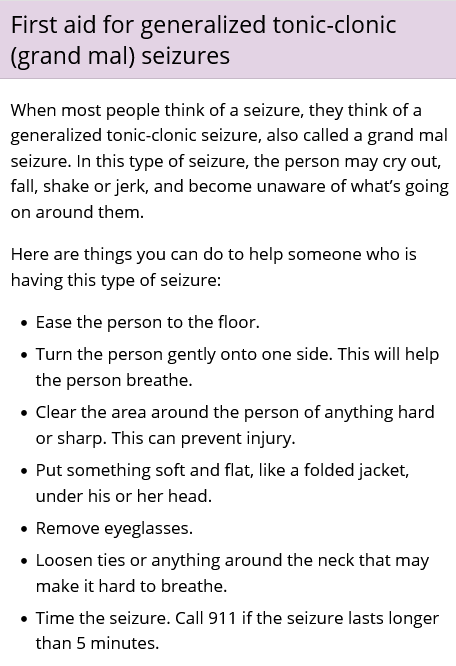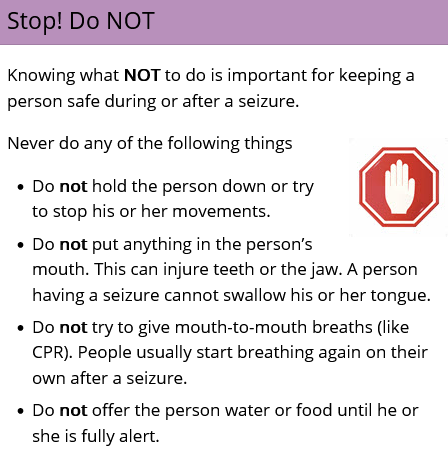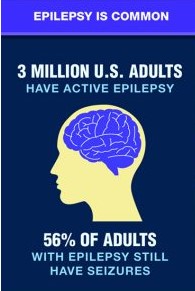At the CDC (Centers for Disease Control and Prevention) we find:
![]()
causes of seizures
most common is epilepsy, especially if medicine is not taken in proper dosage and on time
lack of oxygen
stroke
brain tumor / concussion / increasing intracranial pressure from swelling or internal bleeding in the brain
poisoning
diabetic emergency / low blood sugar
heat stroke
failure to use prescribed anti-seizure medications (often the biggest cause of seizures)
trauma
drug or alcohol use or withdrawl
measles, mumps and other childhood diseases
eclampsia (pregnancy complication)
child with a high fever
child with aspirin poisoning
infection
hit by lightning
high altitude can cause brain swelling
continuing stress from bereavement, divorce, abuse, money/family worries, critical incident stress
From the CDC (Centers for Disease Control and Prevention)

From the CDC (Centers for Disease Control and Prevention)

From the CDC (Centers for Disease Control and Prevention)


From EMS World
“Sentinel seizures occur when an individual experiences a fatal arrhythmia, the brain loses oxygen supply, and thus seizure activity occurs.
The true problem is Sudden Cardiac Arrest, but the seizure is often seen as the first symptom.
Assume the possibility of Sudden Cardiac Arrest
when an otherwise-healthy young athlete collapses and exhibits seizure activity.”
– – – – – – – – – – – – – – – – – – – – – – – – – – – – – – – – – – –
From a professional tour group in Yellowstone National Park:
“If you have a seizure condition that is well managed, your participation in (name of tour group) activities should not be affected. Nonetheless, you should be aware of these potential triggers, which you could experience in Yellowstone, and take precautions:
Low levels of oxygen in the blood
Dehydration
Excessive stress (emotional or physical)
Lack of sleep; fatigue
Hyperventilation and associated blood pH changes
Hypoglycemia, especially in a diabetic
Use of alcohol
Flashing or strobe lights (known as photosensitive epilepsy. If a patient is photosensitive, a seizure also can be induced by sunlight reflecting off wet surfaces, such as moving water or moving rapidly past flickering sunlight.)
Missing a dose of anti-seizure medication (typically the most common trigger)”
and see: How To Call 911.
– – – – – – – – – – – – – – – – – – – – – – – – – – – – – – – – – – –
(Note to on-line users not in my classes: this is a study sheet. It is not complete instruction in first aid or the topic named in the webpage title.)
The author of this webpage, (written as a homework reading assignment for my students), does not give any warranty, expressed or implied, nor assume any legal liability or responsibility for the accuracy, completeness, or usefulness of any information, product, or process included in this website or at websites linked to or from it. Users of information from this website assume all liability arising from such use.
– – – – – – – – – – – – – – – – – – – – – – – – – – – – – – – – – – –